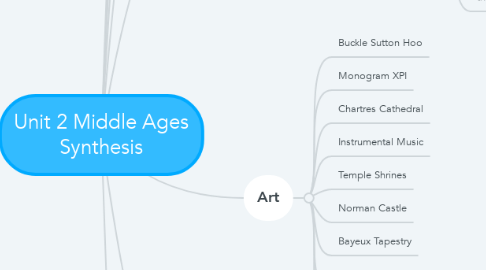
1. Christian Influence
1.1. The 7 Sacraments
1.2. Baptism - Eucharist - Confirmation - Reconciliation - Anointing of the sick - Marriage - Holy orders
1.3. Cathedrals had great influence on the architecture that transpired in the Middle Ages.
2. The word synthesis can be defined as the “combining of individual parts to form a whole”.
3. Rise of the West 500-1100 BCE
3.1. Combining of 3 cultures; Classical - Germanic - Christianity
3.2. The fall of the Romans leads to the rise of the west, and the combining of these 3 cultures.
3.3. Beginning of Feudalism; a vow of military allegiance in exchange for land
3.4. Kings - Nobles - Knights
3.4.1. Vassals - Peasants - Serfs
4. The Age of Charlemagne 768-814 CE
4.1. Chieftain of the Franks who pursued the “dream of restoring the Roman Empire under Christian leadership”.
4.2. In 800 CE, Pope Leo III crowned Charlemagne, establishing the relationship of Church and state.
4.3. Charlemagne fought wars in the name of Christianity.
4.4. Extremely passionate about the teaching of arts and overall education.
4.5. A great example of the way a man from a once Barbaric culture has now adapted into something more due to synthesis.
5. Beyond West: Japan
5.1. After Fujisawa clan took over the imperial throne in eighth century, Japan flourished for about four centuries; 794-1185 C.E.
5.2. Creators of the narrative form of writing a novel! The worlds first author of a novel was Murasaki Shikibu. This was remarkable in itself because women were not allowed to attain a scholarly education.
5.3. Japan and the East also had a Feudal system at the time.
6. The Norman Conquest
6.1. Most commonly known as Vikings, these were the rugged northern men. Raids on England began in 793 C.E., and set off a series of events over the course of a few hundred years.
6.2. In 1066 C.E., William of Normandy took 5000 men across the English Channel into one of the most known battles in history; The Battle of Hastings.
6.3. At the Battle of Hastings, power shifted from Anglo-Saxon to Norman noblemen, and thus creating of the Feudal society in England.
6.4. The Normans are also responsible for The Crusades, which began in 1095 C.E., due to Pope calling for rescuing of Jerusalem from Muslim Turks. Muslim Turks were denying those entry into the Holy Land. This was not a holy war of converting, it was about their land.
6.4.1. The Crusades however went from “holy” war, to financial gain quickly for the church.
6.4.1.1. The Crusades, although ultimately unsuccessful in keeping the lands theirs, did redevelop the trading of East and West
7. Art
7.1. Buckle Sutton Hoo
7.2. Monogram XPI
7.3. Chartres Cathedral
7.4. Instrumental Music
7.5. Temple Shrines
7.6. Norman Castle
7.7. Bayeux Tapestry
7.8. Troubadour Poetry
7.9. Life Along the River on the Eve of the Chi Ming Festival
7.10. Chinese porcelains
8. Literature
8.1. Beowulf
8.2. Song of Roland
8.3. Lindau Gospel
8.4. Medieval Dramas
8.5. Dante’s Commedia
8.6. Tale of Genji
8.7. Japanese(Chinese) Handwriting
8.8. The 7 Sacraments
9. Christendom: Europe In the Age of Faith CA 1000-13000
9.1. Christendom was the Christian community of the Middle Ages, which was ushered in by the Crusades. Christendom was critical in the return to Classical humanism, as well as being attributed to the rise of urban community centers, founding of universities, as well as the majestic cathedrals we are accustomed to seeing.
9.2. The Medieval(Roman Catholic) Church
9.2.1. Not only an enormous religious force, the Roman Catholic Church was no stranger to political force and battle. It exerted either force whenever necessary to ensure survival and advancement of the Medieval Church and remain influential on the West and the world.
9.2.1.1. Prime examples include in 1022, when the Church created the College of Cardinals, to remove any outside influence in picking the next Pope. Another example would be in 1094 when a fire burnt almost all of the Cathedral Chartres to the ground. What transpired after that event was Christians of all walks of life coming together to raise funds and rehabilitate Chartres. That right there shows the power of Christendom and the influence the Church held.
9.2.1.1.1. Pilgrimage was a staple of the Church. It’s ability to connect with other parts of the world was essential in remaining prevalent. Monasteries and abbey churches were built all over Europe after Jesus did not return in the year 1000. Building these revitalized the church.
9.3. Scholasticism
9.3.1. Due to the resurgence of the world and recovering of many works and economic improvement, learning went from almost a predominantly religious oriented idea, back to a educational curriculum. The Church put emphasis on the Liberal Arts, offering two different curriculums.
9.3.1.1. Trivium: Grammar, logic, and rhetoric.
9.3.1.2. Quadrivium: Arithmetic, geometry, astronomy, and music.
9.3.1.3. Professional Studies
9.3.1.3.1. Bachelor degrees were offered after 3-5 years of study, and exams were often given orally. For the fields of medicine, theology, and law, you needed a Masters degree in order to practice legally.
9.3.1.4. One of the first universities recognized was in the city of Bologna, Italy. There they specialized in the study of law. Bologna was a student ran university, whereas the students picked the curriculum and then hired adequate professionals to teach them. In contrast, in Paris, France, the university was led by a teachers guild out of the Cathedral of Notre Dame.
9.3.1.5. Considered by many the “greatest” scholastic of this timeframe was Dominican Thomas Aquinas, who was a great theologian. He lectured and wrote on biblical and theological work. His landmark piece was published a year before he died in 1274, titled Summa Theologica.
9.4. Art
9.4.1. Romanesque Style
9.4.1.1. Gothic Style
9.4.1.1.1. Chartres Cathedral
9.5. Literature
9.5.1. Medieval Dramas
9.5.1.1. Dante’s Commedia
9.5.1.1.1. Summa Theologica
